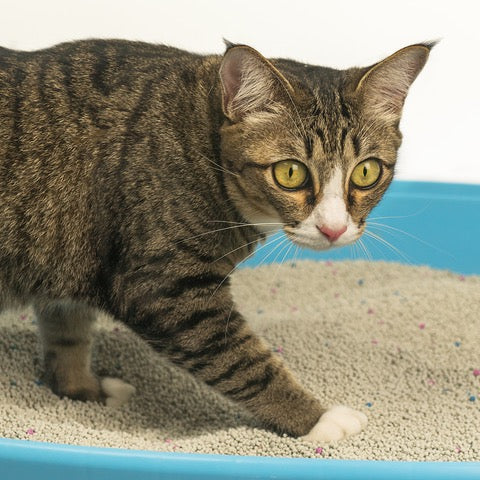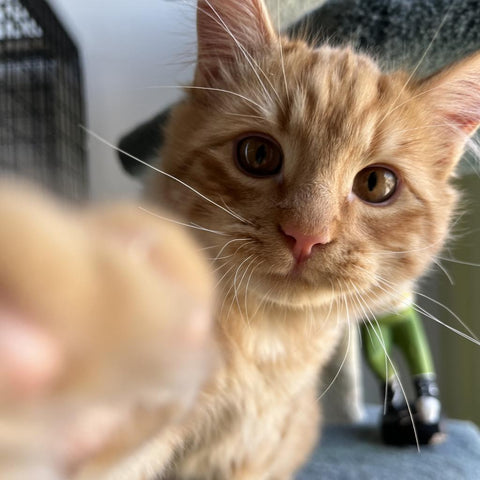Oops - the cat pooped on the bed, now what?
A cat going outside the litter box is a common problem among cat owners, so if you’re dealing with this, you are not alone! As unpleasant as this can be to the owner, the good new is that very often litter box issues can be solved fast and easily. The causes can be divided roughly into three categories: medical issues, problems with the litter box itself, and stress in the home.
Never punish your cat for going outside the litter box. It will not solve the issue. On the contrary, punishing can worsen the problem or lead to behavioral issues, such as aggression or fear. Your cat is not going outside the litter box on purpose or to be mean. It’s always a cry for help.
Medical issues
If a cat who has previously been using his or her litter box without issues starts to go outside the litter box, the first step is to take your cat to the vet to rule out any medical issues. Cats can suffer from several, often easily treatable, medical conditions that can lead to inappropriate elimination. These conditions include urinary tract infections (UTI), Feline Interstitial Cystitis, irritable bowel disease (IBD), kidney stones or a urinary blockage.
Keeping your cat on a consistent, high quality diet and controlling his or her weight will help keep your cat’s digestive system healthy and regular. This can help with litter box usage and make cleaning easier as well.
If you have a senior cats who starts going outside the litter box, it might be just that he or she is having difficulty physically getting into high-sided or covered litter boxes so provide low, uncovered litter boxes for easy access.
Note that if you notice that your cat is not using the litter box at all, this is a medical emergency and you should take your cat to a vet immediately!
Problems with the litter box
If medical issues are ruled out and the problem persists, it’s time to look at other possible causes. Some cats can be very particular about their litter and their litter boxes.
Insufficient number of litter boxes is a common issue that can be easily solved. Just make sure you have at least one litter box per cat plus one extra. Dirty litter boxes is another common issue. So for two cats, you’ll want three litter boxes that you’ll scoop at least once or twice a day depending on your cat’s habits.
Sometimes the issue is with the placement of the litter boxes. Some cats prefer litter boxes that are a bit more out of sight and provide some privacy and shield. Yet others like boxes that are out in the open and won’t make them feel trapped. If a cat if frequently going in the same spot, you can try putting one of the litter boxes there.
Different cats will also have different preferences on the style of litter box or type of litter. Some prefer covered litter boxes whereas others prefer them open. Where one cat likes a low edge, another will choose one with a high edge. For litter, there are several different options, ranging from corn and clay to paper and wood chip to special litters for litter box training. Simply trying out different types of litter boxes and litter as well as the amount of litter can solve house-soiling issues.
Stress and anxiety
Another possible cause for a cat to go outside the litter box may have to do with stress and anxiety. Figuring out the cause of the stress is the first step in addressing the issue. Most commonly this is caused by some recent change in the cat’s environment.
It may be a new pet in the home, a new baby or a new person moving into the home, a new home after a move, a new outdoor cat in the neighborhood. Stress can also be brought on by the passing of one of the pets or people in the home, or by a loved family member moving out.
Cats, like dogs, can also suffer from separation anxiety. One of the common symptoms is urinating outside the litter box. If you believe your cat is suffering from separation anxiety, take steps to provide a low-stress environment and seek advice from a behavioral consultant or your vet on how to work on reducing the anxiety.
To create a low-stress environment, make sure that your cat has cat trees, comfortable spaces for sleeping, toys for play and humans to provide playtime. For stressed out cats, calm, quiet environments are the best. Upon arriving in a new home or during any major changes, it can be helpful to set up your cat in just one room. Avoid disturbing a sleeping cat and never force your cat to cuddle or interact if he or she isn’t ready.
Many cats thrive on routine, so feeding your cat and playing with him or her about the same time each day can be helpful in reducing stress. Playtime will provide exercise, bonding and mental stimulation, which can further reduce stress.
In order to avoid stress, introduce your cat slowly to new pets and people if at all possible. You can provide something with a familiar smell (for example, in case of someone moving out) or something with a new smell (for example, in case of a new pet arriving in the home) to make any changes easier and more gradual.
Catnip and cat pheromone sprays can also help alleviate stress. For severe stress, consult your veterinarian to see if your cat could benefit from medication.




Comments (0)
There are no comments for this article. Be the first one to leave a message!